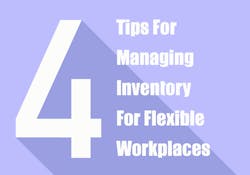4 Tips For Managing Inventory For Flexible Workplaces
Flexible work arrangements are becoming increasingly popular as more and more companies look for ways to entice top talent into their workplace. According to Paul Wolfe, senior vice president of Human Resource (HR) at Indeed, "In today's tight labor market, proper work-life balance practices are essential for employee retention." And “one EY survey found that nearly 40 percent of young workers would even consider moving to a different country in order to achieve better balance in their lives.” (CNBC) In order to remain competitive in the job market, many companies are offering flexible scheduling. Flexible scheduling could mean remote workers who intermittently pop in and out of the office as well as employees who work slightly off shift. For instance, if a company’s typical workday is from 9 to 5, then a flex schedule may be from 10 to 6.
These shifts in the schedule can make a difference in how you stock your market and when. And the consequences of failing to accurately account for the inventory needed in a location can include an increase in fresh food spoilage, or not having the right, or enough, products to accommodate the fluctuating employee count. All of this means a loss of revenue for you. Here are a few things to keep in mind when entering a location with a flexible workforce.
1. Talk to the location about their flexible workforce and adjust accordingly. For instance, if a significant amount of their employees start later in the morning, your breakfast sales could suffer.
2. In addition, if a significant number of employees are only in on certain days of the week, adjust your delivery days to match. Perhaps many of the remote workers come into the office on Tuesdays for company meetings. Then you know that you won’t need to stock as many fresh items at the end of the week.
3. Review your inventory and sales reports regularly. A weekly review will help you spot trends in what products are selling and when.
4. Offer incentives. The remote workers who may come into the office once a week may not see the immediate value of the micro market since it is not a part of their daily work life as it is for traditional employees. Consider taking a percentage off of selected products or crediting them funds to use the market if it’s been a while since their last purchase.
The biggest thing when working with any location, including a location with a transitive workforce, is to communicate with the host location. They would know best what their employees need and you can make recommendations based on your expertise. Arm yourself with as much knowledge as possible so that you can mobilize YOUR workforce accordingly.
